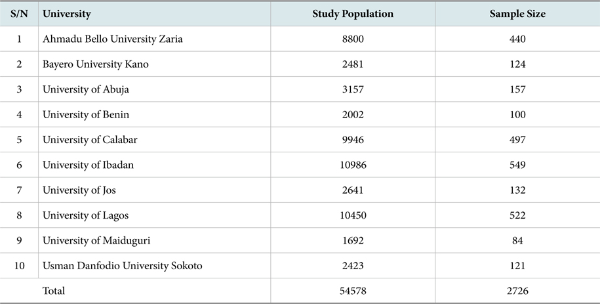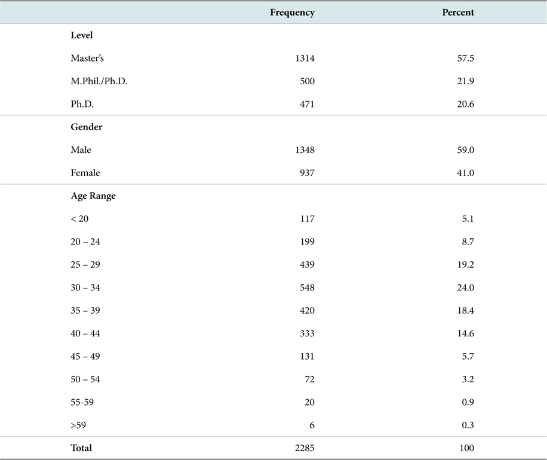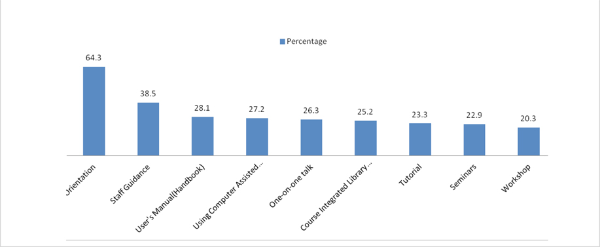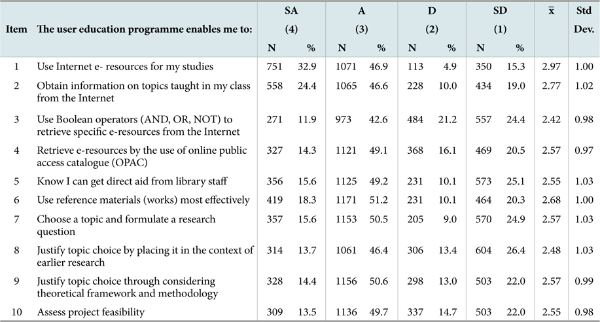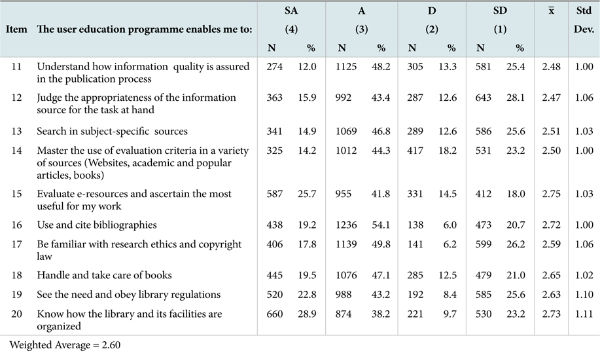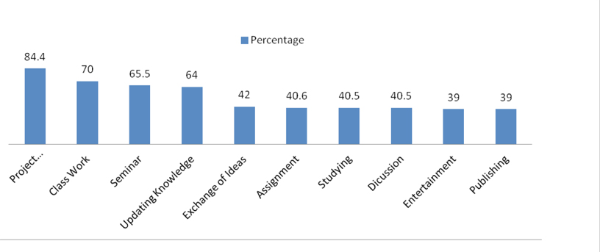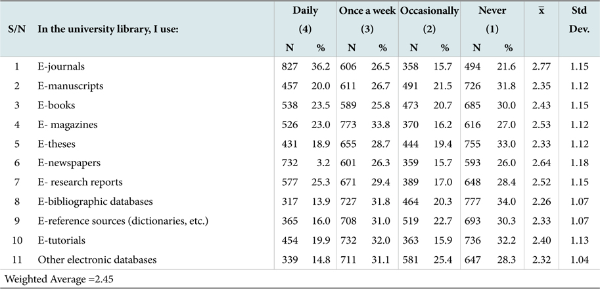1. INTRODUCTION
E-resources are becoming increasingly available in university libraries in Nigeria, facilitating postgraduates’ access and use of current and relevant literature for their studies and research. Since a decade ago, a paradigm shift has been noticed in collection development policies and practices in university libraries in Nigeria, with the purchase of print resources decreasing and those of e-resources increasing (Okiki & Asiru, 2011). Sharma (2009) noted that students are looking for convenient and time saving responses as they move from using physical materials to e-resources in their libraries. The university library is the academic heart of the university system and its basic purpose is to provide its immediate users with resources, services, and facilities that facilitate teaching, learning, and research.
The users of university libraries include students (undergraduates and postgraduates) and staff. Postgraduate students form a vital component of users of library resources due to their research activities. The library’s resources include both print and e-resources. E-resources are information sources that are available and can be accessed electronically through computer-networked facilities such as online library catalogues, the Internet and the World Wide Web (WWW), CD-ROM databases, etcetera. Types and forms of e-resources in university libraries include e-journals, e-data archives, e-manuscripts, e-maps, e-books, e-magazines, e-theses, WWW, e-newspapers, e-research reports, and e-bibliographic databases (Univ. Chicago Library, 2014).
The benefit of use of e-resources for postgraduate students as identified by Mathew and Sornam (2007) at Kerala Agricultural University, India are as follows: ease of access; availability of accessibility from different locations; full text can be accessed remotely; they are user-friendly; they meet student needs and expectations. However, Sinha et al. (2011) summarised the benefit of e-resource use by postgraduate students as giving easy access and accurate and comprehensive information. Also, Khan et al. (2011) submitted that the purpose of e-resources use among postgraduate students is for studying.
Considering the importance and purpose of e-resource use by postgraduate students, providing accurate and timely information for their research efforts, this probably explains the underlying principle for the acquisition of e-resources in university libraries. Previous studies have been carried out on the use of e-resources among postgraduate students in university libraries (Swain & Panda 2009; Okiki & Asiru 2011), and in most cases studies show that they ameliorate and fasten student research. Similarly, Bar-llan et al. (2003), in their study on the use of e-journals among postgraduates and academic staff of Israeli universities, submitted that their use increased with time and variables such as age and academic position were inversely related to the use of e-journals. In a related study, Abubakar and Adetimirin (2015) measured the relationship between computer literacy levels of Nigerian postgraduate students and their use of e-resources. The result shows that use was low due to the moderate computer literacy of the students. Indeed, the study was concurrently undertaken with the present study (same methodology, scope, and respondents).
University libraries are however making efforts at determining suitable factors to retrieve information resources for use by users, particularly those postgraduate students that are involved in research and other scholarly works. This is with the view to easing their information search, retrieval, and use. However, some postgraduate students may enrol for their studies with little or no education on library services and resources. The education acquired might probably not be adequate to enable them to explore and exploit library services and resources for their research, learning, and other scholarly activities. This scenario will pose some degree of impediment during their research work.
The most likely cause of low use of e-resources by postgraduate students in university libraries for their research work is probably lack of user education. Ajala (2007) and Agyen-Gyesi (2008) opined that lack of user education is the major impediment to the use of e-resources by research students. User education is critical for retrieving e-resources for scholarly work. Also, educating library users implies equipping and providing them with training on how to use library tools in order to use e-resources. Cram (2008) defined user education as an attempt to change the behaviour of an individual who will be developing a search strategy to retrieve useful information.
User education is crucial to the use of e-resources because postgraduate students need to be educated and learn searching skills to be able to retrieve and use e-resources for their research. To support this view, Ozoemelem (2009) argued that postgraduate students must acquire and put into practice necessary information searching skills to be able to retrieve e-resources among postgraduate students of the Department of Library and Information Science of Delta State University, Abraka, Nigeria. Mohammadi et al. (2008), citing Clarke (1999), gave credence to these views that student at the postgraduate levels should be given detailed instruction in methods of searching and formulation of clear requests necessary to use library resources. The purchase of e-resources in Nigerian university libraries, particularly in the harsh economic situation the libraries are facing, calls for attention on how these e-resources can be put into judicious use by postgraduate students for their research work.
Some of the postgraduate students might have received training on user education and probably could search and retrieve e-resources for their research. This might be due to their course of study such as those pursuing degrees in computer and information sciences. For improved academic performance, all postgraduate students are expected to retrieve and use e-resources without hitch and waste of time. This will eliminate aggravation of searching needed information and promote scholarship. Postgraduate students that acquire user education guidance are more likely to locate, retrieve, and use e-resources in maximizing their learning than those without user education instruction (Omelezor, 2010). Nithyanandam et al. (2006) posit that “if study programmes are to be based on the students’ active search for knowledge, then students must acquire more sound knowledge for searching, evaluation and utilisation of scientific and scholarly information.”
It is generally believed by some researchers such as Ren (2000) and Tella et al. (2007) that one of the causes of poor performance of the majority of postgraduate students in universities is inability to effectively use the e-resources in their libraries, which consequently affects their overall scores. E-resources in university libraries should always be available to provide research information needs in addition to complementing study resources. Previous studies have argued that user education is necessary for effectively searching needed information in university libraries (Busayo, 2003; Badu & Markwei, 2005; Mohammadi, Moghaddam, & Yeganeh, 2008; and Omeluzor, 2010) because user education is mainly concerned with communication processes involving the interaction of users with any type of library (Bundy, 1999; Singh & Jindal, 2009).
Bhatti (2010) explored the user education level of postgraduate students in university libraries in Pakistan and reported that user education was faced with constraints; consequently, students demonstrated low library use and low frequency of use of all types of materials. He recommended that the delivery of user education should be incorporated in the university curriculum, and is not to be treated as a separate subject. This report was similar to those of Singh and Jindal (2009), who reported from their study on promoting the use of e-resources at Delhi University Library System (DULS) India that graduate students agreed that user education was important for their learning and research. They added that their user education programme has provided a proper platform for direct interaction with library users and posit that a user education programme coupled with robust ICT infrastructure will create high access and usability of e-resources. Similarly, McDowell (2002) stated that user education is critical in e-resources usage and needs to be developed taking into account the growing opportunities presented by e-resources within the context of learning.
In order to improve library user education and to produce informational evidence on the importance of this core library service, the Hong Kong University of Science and Technology Library, Hong Kong, mandated Wong et al. (2006) to conduct a formal assessment on its instruction programme in 2006 for all programmes. A group of 688 users from 25 one-shot sessions were surveyed by a questionnaire from four to eight weeks after the sessions were conducted. Results showed that the majority of attendees remained positive about the usefulness of the library sessions; they retained and used the skills learned; the overall ratings of the library sessions and the instructors were comparable to those of the university’s credit course ratings.
In many African countries, user education interventions have not yet been seriously considered or implemented in most university libraries (Mugyabuso et al., 2008). To prove this assertion, Baro (2011) conducted a study on information literacy education in library schools in Africa to ascertain whether librarians are taking the leading role in the development of user education in universities. His study revealed that only a few library schools have successfully integrated a stand-alone information literacy course into the curriculum. Lwehabura and Stilwell (2008) found that user education is still new in the university curricula in Tanzania. They added that a lack of explicit user education policies on how information literacy activities should be conducted has resulted in some existing user education programmes not being allocated official time within university timetables.
In Nigeria, similar studies (Aguolu & Aguolu, 2002; Folorunso et al., 2006) have been carried out on the impact of user education on students’ use of library resources in university libraries. Most of the results revealed that the libraries concentrated on purchasing print materials rather than educating their users for optimal use. Similarly, Ozoemelem (2009) studied the use of e-resources by Library and Information Science (LIS) postgraduate students of Delta State University, Abraka, Nigeria and revealed that the students were not optimally utilizing e-resources because of lack of awareness, and advocated for intensive user education programmes for the postgraduate students. In addition, Popoola and Zaid (2007) reported that many Nigerian university libraries have not been taking user education very seriously, therefore not promoting the use of library products and services. Adeleke and Olorunsola (2010) concluded that the user education training programme offered in Redeemer’s University Library, Nigeria, enabled a good number of students to attain information literacy, but much is needed to be done by both libraries and faculty to attain the desired result of making students information-literate.
The pertinent question is whether university libraries derive value for the money invested on e-resources. This question has prompted researchers to place much concern on the paucity of literature on the use of e-resources in university libraries. Therefore, to justify the investment on e-resources, it is the library’s responsibility to ensure its e-resources are beneficial to its users.
1.1. Research Questions
The following research questions were answered in the study:
-
(i) What are the methods through which postgraduate students acquired user education in the university libraries?
-
(ii) What is the level of user education possessed by postgraduate students in federal universities in Nigeria?
-
(iii) What is the purpose of e-resources usage by postgraduate students in federal university libraries in Nigeria?
-
(iv) What is the frequency of use of e-resources by postgraduate students in federal university libraries in Nigeria?
2. METHODOLOGY
The study adopted the descriptive survey research design of the ex post facto type. The population for the study comprised 54,578 postgraduate students in all the 16 Federal Conventional Universities (with different subjects/courses offered) and 16 e-resource librarians. Specialised and newly established universities in the year 2013 were excluded because they do not have postgraduate programmes. The multi-stage sampling technique was adopted to select 10 out of the 16 federal universities. Purposive selection of four faculties (Arts, Education, Sciences, and Social Sciences), and purposive selection of two departments in each faculty with the highest number of postgraduate students was done, while the proportionate random sampling technique was used to select postgraduate students (Table 1). A sampling fraction of 5% was used to select the sample of 2,726 postgraduate students. A questionnaire was used to collect data. Data collected were analysed using descriptive statistics, viz: frequency count, percentage, mean, and standard deviation. Also, Pearson Product Moment Correlation was used to test for relationship for the hypothesis.
3. SIGNIFICANCE OF THE STUDY
The present study is significant in the area of use of e-resources by postgraduate students in Nigerian university libraries because it has provided the empirical basis for postgraduate students to swing their preferences from print materials to using more of e-resources in their university libraries. This will boost their learning and research activities; in turn, the research output could solve the nation’s social problems and add knowledge for further research efforts. As society’s problems are being solved, there will be development for the nation (Nigeria).
In the area of practice the study is significant because it has revealed the most used types of e-resources in the university libraries, and this will inform university librarians on how to invest in the provision of e-resources. In addition, university libraries could benefit by conserving spaces meant to place print materials, thereby utilizing them to create more access points for e-resources use. This will translate into better working conditions for the staff and also cut budgets for printed materials as the university librarians can enter negotiations into e-resource sharing when more postgraduate students begin to shift their preferences to e-resource use.
This study will also help library managers/university librarians in the aspect of policy statements on how to improve on e-resource access and utilization by setting a conducive e-resource policy use and designing effective products and services in university libraries. It may further provide impetus to designing a better user education method for postgraduate students. The study is further significant because it has added literature on librarianship in the area of user studies.
4. RESULTS AND DISCUSSION
Today, university libraries in Nigeria have incorporated various electronic resources for their collection developments to fulfil the requirements of all categories of library users. The e-resources contain both local and international informational resources and databases such as e-journals, e-books, e-magazines, e-research reports, e-newspapers, and so on. These are essential for the educational process and research. Research activities are performed by postgraduate students and the subscription and use of e-resources provided by university libraries in Nigeria will improve such activities.
Among the three levels, the numbers at the master’s level were 1,314 (57.5%), M.Phil./Ph.D. 500 (21.9%), and Ph.D. 471 (20.6%). This reveals that a majority of the postgraduate students in this study were at the master’s level (Table 2). Also, there were 1,348 (59.0%) male postgraduate students and 937 (41.0%) female postgraduate students. Table 2 also indicated that 548 (24.0%) and 420 (18.4%) of the sample were between the ages of ‘30-34’ and ‘35-39’ respectively. Only 6 (0.3%) were above 59 years. This shows that most of the postgraduate students were within ‘30-39’ years. This implies that most Nigerian students pursue their postgraduate programmes in their thirties.
Research Question 1: What are the methods through which postgraduate students acquired user education in the university libraries?
The major methods for acquisition of user education by the postgraduate students were library orientations (N=1,470; 64.3%), user education through library staff guidance (N=880; 38.5%) and users’ manuals or information handbooks (N=643; 28.1%) as presented in Fig. 1. It was found in this study that the major method for acquisition of user education by the postgraduate students was the library orientation, by which the orientation is given to fresh students in the universities. It could be argued to be so because fifty percent of the librarians in charge of e-resources/systems librarians interviewed responded that they taught their postgraduate students user education via library orientations; few of the e-resources librarians responded that they only create awareness on demand. Yet, some do not teach user education to their postgraduate students at all. Over sixty-four percent of the postgraduate students had acquired user education via a library orientation. This percentage is overwhelming as the other methods are of low frequency. This will have negative implications because postgraduate students’ ability to maximise the use of their library’s e-resources will be limited, as methods to learning about the library’s resources and facilities were limited.
The other methods for acquiring user education should be inculcated to create a wider sensitisation on the use of the library’s e-resources. In practice today, postgraduate students’ enrolment in universities is growing astronomically and this will pose a challenge to librarians if the library orientation is the major method for user education acquisition. Besides, the purpose of user education programmes is to enable students to patronise libraries for their academic activities and eventually become sophisticated users of the resources. This finding agrees with Suleiman’s (2012) submission that postgraduate students should attend user education classes apart from other avenues of user education. Ninety percent of his respondents agreed that attending user education classes would enable them find relevant information they need. However, John (2008) argued that library orientation is beneficial because it will produce more library users. Therefore, the finding of this study in respect to the major methods of acquiring user education is in consonance with that of John (2008).
Research Question 2: What is the level of user education possessed by postgraduate students in federal universities in Nigeria?
Table 3 (a and b) shows that 16 items out of the 20 items had high mean scores ranging from 2.50 to 2.97. This revealed that most of the items are above the mean of 2.50 of the scale of maximum of 4 points. It thus implied that the postgraduate students’ user education was relatively high. The other four items had low mean scores below the 2.50 mean of the scale. The weighted average of 2.60 summarised the mean scores, implying that the level of user education of the students is slightly above average.
This implies that most of the students had a reasonable level of library user education. This is expected because over fifty-six percent of the postgraduate students had acquired library user education. In addition, some might have had sound user education at their undergraduate days apart from the library orientation and staff guidance they received at the postgraduate level. Furthermore, 50% of the librarians in charge of e-resources/systems librarians interviewed attested to the fact that their postgraduate students’ user education was reasonable enough for retrieving e-resources in the library. However, 1% were not categorical but responded that the postgraduate students could retrieve e-resources only if they attend the library orientation. This assertion was validated by Tramullas and Casabon (2010), that postgraduate students need to be instructed on how to exploit and use e-resources because university libraries spent huge sums of money on providing such resources and services. Questions could be asked on why some students use libraries more than others. And why is using some libraries easier than others? Perhaps, the main factor affecting library use is familiarity with how the library, as a whole, can be optimally used. For the postgraduate students to optimally use the library and its resources, they have to attend the user education programme.
User education programmes are an important aspect of library services because they inform students of the availability, location, and use conditions of e-resources in their libraries. Different, however, is computer literacy that enables the students to retrieve e-resources from computerised systems. Abubakar and Adetimirin (2015) reported among the same set of postgraduate students, using the same methodology and usage of e-resources as the dependent variable, that there is a positive and strong relationship between the students’ use of e-resources and their computer literacy. It can be inferred from this study that the difference between the relationship of “user education and the students’ use of e-resources” and that of “computer literacy levels of the students and their use of e-resources” is that user education creates awareness of availability, location, and conditions of usage, among other instructions, while computer literacy enables students to retrieve e-resources from computerised systems. In any case, both user education and computer literacy can be considered as twin components for identification and retrieval of e-resources by the students in their libraries. Distinctively, this study measured the influence of user education on postgraduates vis-a-viz their use of e-resources. The level is relatively high, while that of computer literacy was moderate. Another difference is that the researchers were able to rank the purposes of usage of the use of e-resources for this study.
It can be inferred from this finding that in most of the university libraries, user education was given attention and this has come to bear on the postgraduate students’ user education level, which was slightly above average. This result is in line with that of Alimohammadi and Sajjadi (2008) who submitted that if user education is given attention and organised in university libraries, it will help students locate, retrieve, and use information. Clarcke (1999) reviewed the development of user education within the context of arguments for and against it for postgraduate students and submitted that without user education, university libraries’ investments would be wasted for lack of use. Nevertheless, Agyen-Gyesi (2008) opined that the compartmentalisation of universities into faculties and departments has necessitated the introduction of an enhanced user education because of increases in the amount of literature.
Further analysis revealed the levels of user education of the students using the index mean (x) of 2.50 as cut off points for classification (Fig. 2). Those with mean score lower than the index mean of 2.50 were 265 (11.6%) in number and those with mean score higher than the index mean comprised 1,309 (57.3%) out of the 2,285 postgraduate students. This implies that the students had high library user education.
Research Question 3: What is the purpose of e-resources usage by postgraduate students in federal university libraries in Nigeria?
Fig. 3 indicates that the main purposes of use of e-resources by the postgraduate students were project report/ thesis writing (N = 1,929; 84.4%), classwork (N = 1,606; 70.0%) and seminars (N =1,499; 64.0%). However, the purposes of use of e-resources such as for exchange of ideas, assignment, discussion, studying, entertainment, and publishing were low. These latter groups of purposes of use of e-resources constituted those ones that could be described as secondary, especially with postgraduate students whose main courses of study have to do with research and seminar presentations.
Research Question 4: What is the frequency of use of e-resources by postgraduate students in federal conventional university libraries in Nigeria?
Table 4 revealed that the postgraduate students frequently used only four of the 11 e-resources listed. These were e-journals (x = 2.77), e-newspapers (x =2.64), e-magazines (x = 2.53) and e-research reports (x = 2.52). The other 7 e-resources were not used to any significant extent. The weighted average of 2.45 summarises the results to the effect that the postgraduate students’ frequency of use of e-resources was low.
This finding is not cheering to those university libraries that spent enormous funds to subscribe to e-resources for users. The frequency of use of e-resources ranges from daily to occasionally. This finding is in harmony with those of Okiki and Asiru (2011) who reported that postgraduate students from the Universities of Lagos, Ibadan, and Ife used e-resources daily, weekly, monthly, and occasionally. But the breakdown generally revealed low frequency of e-resource use by the postgraduate students of the three universities. Among the most used e-resources, the majority of the respondents used them once a week and occasionally, while only a few respondents used e-resources daily.
The low use of e-resources has not reflected student levels of user education. The four e-resources frequently used are expected because, worldwide, postgraduate students use them for academic activities. However, the other e-resources are supposedly to be put to use by the students based on their levels of user education. Perhaps, awareness of such e-resources was not given to the students. And even if awareness was given to them, they were not skilled in the use of the 7 e-resources. It was, however, revealed that use of e-resources is not commensurate to investments made in acquiring these resources.
The low use of e-resources by the postgraduate students has dual implications. First, this will amount to massive failure of funding allocated for the payment of e-resources in the university libraries because the provision of the e-resources was unjustified, for lack of use. Secondly, the postgraduate students’ research output will not be qualitative enough for lack of use of current and standardised information resources. It is clear from the study that the four e-resources were accepted by the postgraduate students, but the frequency of usage of the other 7 e-resources was not found to be at optimum level. Many of the respondents might be unaware and have not used them, perhaps, for their scholarly activities; therefore, the library should take initiatives to organize orientation programmes and user awareness programmes for these 7 e-resources.
Test of hypothesis: There is no significant relationship between user education provision and use of e-resources by postgraduate students in university libraries in Nigeria.
Pearson product moment correlation was used to test for this relationship. Table 5 reveals that there is a positive and slightly strong relationship between postgraduate students’ library user education and their use of e-resources (r = .318; df = 2284; p < .05). This relationship, therefore, is significant and means as library user education improves, use of library e-resources also improves. Based on this, the null hypothesis was rejected.
5. CONCLUSION
The use of e-resources by postgraduate students in Federal Conventional University Libraries in Nigeria is essential for promoting scholarships. The postgraduate students’ level of user education was reasonable; however, this did not influence their use of the e-resources in their libraries. It was revealed that due to lack of continuing user education on most e-resources in the libraries, the e-resources were not fully retrieved and used for research and other scholastic works. Therefore, the lack of continuing user education for postgraduate students should be viewed as an obstacle that should be overcome in order to influence the students to fully optimise and benefit from the e-resources provided in their university libraries.
Recommendations University libraries should employ all methods (library orientations, course integrated library instruction, staff guidance, user’s manuals, one-on-one talks, tutorial, seminars, workshops, and using computer assisted learning) for acquiring user education. This should be made compulsory for all postgraduate students in order to improve the retrieval and use of e-resources. There should be feedback mechanisms to evaluate user education programmes between the library and the postgraduate students. User education in university libraries should be a continuous programme which should be tailored not only on the use of available e-resources, but also to make the students information literate.
References
, ((2015)) Influence of computer literacy on postgraduates’ use of e-resources in Nigerian University libraries Library Philosophy and Practice (e-journal), 1207, 1-7 http://digitalcommons.unl.edu/libphilprac/1207.
Libraries and information management in Nigeria: Seminar essays on theses and problems (, ) ((2002)) Maiduguri, Nigeria: Ed-Inform Services Aguolu, C.C., & Aguolu, I. E. (2002). Libraries and information management in Nigeria: Seminar essays on theses and problems (p. 85). Maiduguri, Nigeria: Ed-Inform Services. , p. 85
((2008)) User education at the Kwame Nkrumah University of Science and Technology (KNUST) Library: Prospects and challenges Library Philosophy and Practice http://digitalcommons.unl.edu/libphilprac.
, ((2006)) Library instruction: Past lessons, future plans Library Philosophy and Practice, 9(1) http://digitalcommons.unl.edu/libphilprac/99.
((2010)) An evaluation of user-education programmes in the university libraries of Pakistan Library Philosophy and Practice www.webpages.uidaho.edu/~mbolin/bhatti2.htm.
What is user education? () ((2008)) University of South Australia Cram, L. (2008). What is user education? University of South Australia. Retrieved from www.unisanet.unisa.edu.au/012561/Seminars/Week_9.htm. , Retrieved from www.unisanet.unisa.edu.au/012561/Seminars/Week_9.htm
Internet access, use and gratification among university students: A case Study of the Islamia University of Bahawalpur, Pakistan (, , ) ((2011)) Khan, S. A., Khan, A. A., & Bhatti, R. (2011). Internet access, use and gratification among university students: A case Study of the Islamia University of Bahawalpur, Pakistan. Chinese Librarianship: an International Electronic Journal, 31. Retrieved from http://www.iclc.us/cliej/cl32KKB.pdf. , Retrieved from http://www.iclc.us/cliej/cl32KKB.pdf
, , ((2008)) Students’ perception of the impact of user education on the use of reference resources: An Iranian experience Library Philosophy and Practice (e-journal), 199 http://digitalcommons.unl.edu/libphilprac/199.
User education programmes and academic libraries((2006)) 4th International Convention CALIBER – 2006, Gulbarga, INFLIBNET Centre, Ahmedabad Nithyanamdam, K., Kanniyappan, E., Arul Dhanakar, M., & Rajasekar, V. (2006). User education programmes and academic libraries. 4th International Convention CALIBER – 2006, Gulbarga, INFLIBNET Centre, Ahmedabad. , NithyanamdamK.KanniyappanE.Arul DhanakarM.RajasekarV.
, ((2011)) Use of electronic information sources by postgraduate students in Nigeria: Influencing factors Library philosophy and Practice (e-journal) http://digitalcommons.unl.edu/libphilprac.
User education and use of library at Babcock University, Nigeria () ((2010)) Omeluzor, S. U. (2010). User education and use of library at Babcock University, Nigeria. The Free Online Library. Retrieved from http://www.thefreelibrary.com. , Retrieved from http://www.thefreelibrary.com
((2009)) Use of electronic resources by postgraduate students of the Department of Library and Information Science of Delta State University, Abraka, Nigeria Library Philosophy and Practice (e-journal) http://digitalcommons.unl.edu/libphilprac.
Promoting the use of E-resources and research(Sept. 27-29, (2009)) 7th International CALIBER, held at Uppsala Singh, R., & Jindal, S. C. (2009). Promoting the use of E-resources and research. 7th International CALIBER, held at Uppsala, Sept. 27-29. Retrieved from www.inflibnet.ac.in/caliber2009/caliberPDF/54. , SinghR.JindalS. C., Retrieved from www.inflibnet.ac.in/caliber2009/caliberPDF/54
Usage of electronic resources available under UGC-INFONET digital library consortium by Assan University library users(2011) International CALIBER, Goa University, Goa Sinha, M. K., Singha, G., & Sinha, B. 2011. Usage of electronic resources available under UGC-INFONET digital library consortium by Assan University library users. International CALIBER. Goa University, Goa. Retrieved from http://ssrn.com/abstract=2710314. , SinhaM. K.SinghaG.SinhaB., Retrieved from http://ssrn.com/abstract=2710314
((2012)) User education programs in academic libraries: The experience of the International Islamic University Malaysia students Library Philosophy and Practice (e-journal), 774 http://digitalcommons.unl.edu/libphilprac/774.
Self-efficacy and use of electronic information as predictors of academic performance (, , , ) ((2007)) Tell, M., Tella, A., Ayeni, C.O., & Omoba, R. O. (2007). Self-efficacy and use of electronic information as predictors of academic performance. Electronic Journal of Academic and Special Librarianship, 8(2). Retrieved from http://southernlibrarianship.icaap.org/content/v08n02/tella_a01.html. , Retrieved from http://southernlibrarianship.icaap.org/content/v08n02/tella_a01.html
Scientific information retrieval behavior: A case study in students of philosophy(15-16 June, (2010)) I Congreso Español de Recuperación de Información (CERI 2010), Madrid, Spain Tramullas, J., & Casabon, A. (2010). Scientific information retrieval behavior: A case study in students of philosophy. Paper presented at the I Congreso Español de Recuperación de Información (CERI 2010), Madrid, Spain, 15-16 June. Retrieved from http://ir.ii.uam.es/ceri2010/papers/ceri2010-tramullas.pdf. , TramullasJ.CasabonA., Retrieved from http://ir.ii.uam.es/ceri2010/papers/ceri2010-tramullas.pdf
University of Chicago Library ((2014)) Collections and exhibits University of Chicago Library. (2014). Collections and exhibits. Retrieved from https://www.lib.uchicago.edu/collex/. , Retrieved from https://www.lib.uchicago.edu/collex/
